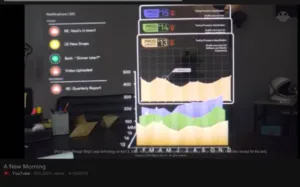When you get as much money as Magic Leap from investors, you have to keep the hype up to not only make them feel good, but also to entice them, and others, to give you even more money. Magic Leap may be the first start up ever that has no further investment needs after the first significant round, especially with the rumors about a semiconductor plant being part of the investment strategy.
Source: YouTube Video from Magic Leap – A new morning
The latest marketing news from Magic Leap is a new video (available on YouTube – http://tinyurl.com/hr6nvto) that shows the use of augmented reality for a mix of shopping, communications and work in a home setting. Part of the video is the use of some kind of visual interface that is based on the scene you are looking at. Maybe if you blink twice or there may be a distinct interface button (like a mouse button), but anyway, the system allows you to interact with the shown content that is also pinned to the background. If you move your head you see a clean canvas for viewing more information.
Analyst Comment
All this reminds me a lot of the HoloLens demos from last year. One would expect Magic Leap to provide a similar function, but the video also shows one critical aspect of AR devices today, the issue with ambient lighting. When you pay attention to the background you realize that it is dark, as it would be in your room at dawn when you do not turn on the lights. Of course, that gives you a much better contrast with the AR content floating in midair. Having a dark background (like in a VR device) will give you the best contrast ratios and therefore also the best image quality. The brighter the ambient lighting conditions are, the more washed out the content will appear. This is very comparable to the first smartphones when used outside. The displays were overpowered with ambient lighting and the user could not see anything.
There are some patents that address this issue by adding a layer that decreases the light throughput in certain areas (basically they are blocking the outside light behind any AR content) to allow for a better contrast ratio. Magic Leap seems to lower all the background light by adding a sunglass shade over the whole area.
It shows that the augmented reality devices still have some R&D work ahead of them before they provide a consumer-friendly environment that fulfills the consumers expectations of high quality imagery which they have become accustomed to with their UltraHD living room TVs. – NH

